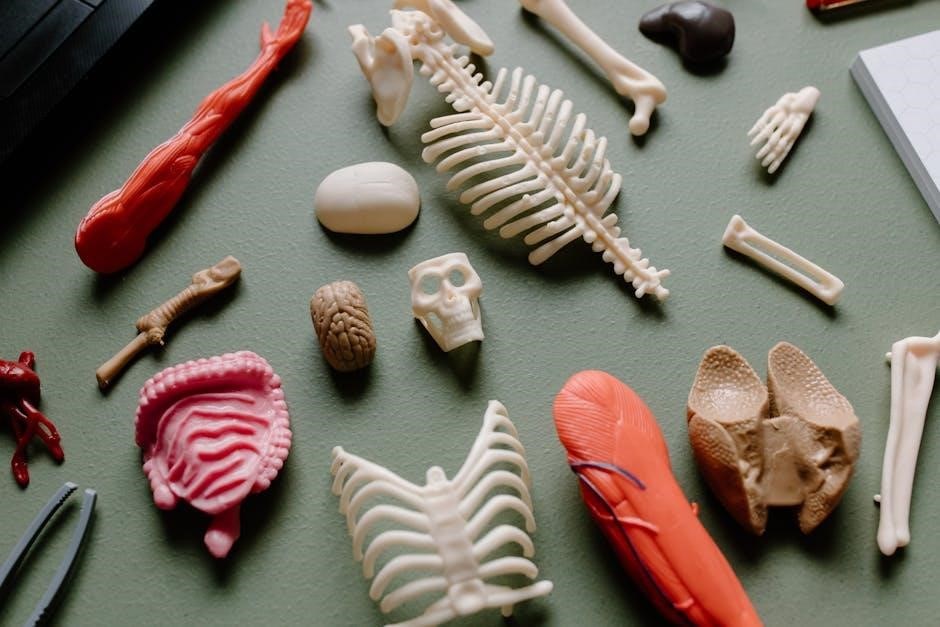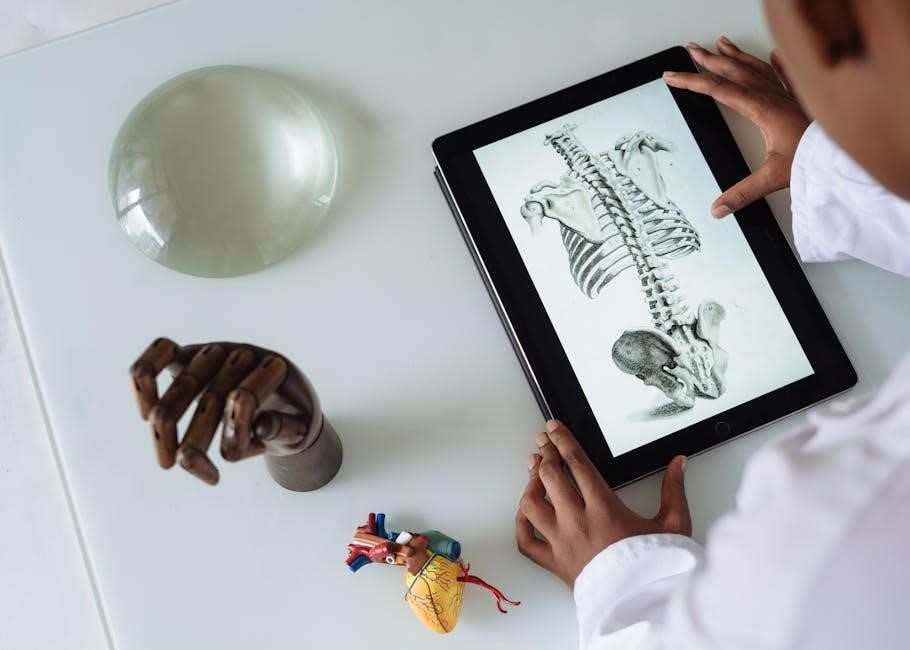
Skeletal System Worksheets: An Overview
Skeletal system worksheets are educational tools designed to help students learn about the human skeletal system. They cover topics like bone names‚ functions‚ and the differences between the axial and appendicular skeletons. These worksheets are available in printable PDF format.
Skeletal system worksheets serve as an engaging and effective method to introduce students to the complexities of the human skeleton. These worksheets offer a structured approach to learning about bone names‚ locations‚ and functions. They cater to various grade levels‚ ensuring that the content is age-appropriate and challenging. Worksheets often include diagrams for labeling‚ fill-in-the-blank exercises‚ and quizzes.
The benefits of using these worksheets extend beyond rote memorization. Students develop a deeper understanding of how the skeletal system supports the body‚ protects vital organs‚ and enables movement. They also learn about the importance of joints‚ cartilage‚ and bone marrow.
Teachers and parents can easily access free printable skeletal system worksheets online. These resources provide flexibility in lesson planning and allow students to reinforce their learning at home. By incorporating skeletal system worksheets into the curriculum‚ educators can create a more interactive and memorable learning experience for their students. Worksheets also offer a great way to review before tests.

Types of Skeletal System Worksheets

Skeletal system worksheets come in varied forms‚ including those tailored for different grade levels‚ labeling exercises‚ and focus on bone functions. Axial versus appendicular skeleton worksheets help students understand the skeleton’s organization by diving into the different bones and joints.
Worksheets for Different Grade Levels (K-6)
Skeletal system worksheets designed for kindergarten to sixth-grade students offer age-appropriate content. For younger children (K-2)‚ worksheets might involve simple labeling of major bones like the skull‚ ribs‚ and femur‚ often using coloring activities to engage them. These introductory worksheets focus on basic bone recognition and understanding the skeleton’s role in support and movement.
In grades 3-4‚ worksheets introduce more detailed bone names and functions‚ differentiating between the axial and appendicular skeletons. Activities could include fill-in-the-blank exercises‚ matching games‚ and simple diagrams to label. These worksheets aim to build a foundational knowledge of skeletal anatomy and its importance.
For grades 5-6‚ worksheets delve deeper into the skeletal system‚ covering joint types‚ bone structures‚ and the role of cartilage and bone marrow. Students may encounter questions about bone fractures‚ bone marrow‚ and the importance of calcium. Advanced labeling and comparative analysis between bone types may also be introduced.
Labeling the Skeleton Worksheets
Labeling the skeleton worksheets are fundamental tools for learning skeletal anatomy. These worksheets typically present a diagram of the human skeleton‚ with various bones indicated by lines or arrows‚ prompting students to identify and label each bone correctly.
These worksheets are available for various grade levels‚ each tailored to the students’ learning stage. Simpler versions for younger students focus on labeling major bones like the skull‚ rib cage‚ spine‚ femur‚ and tibia. As students advance‚ the worksheets include more bones‚ such as the carpals‚ metacarpals‚ tarsals‚ metatarsals‚ and specific bones of the skull and spine.
The benefits of using these worksheets are numerous. They reinforce the recognition and memorization of bone names‚ improve anatomical understanding‚ and provide a hands-on learning experience. Some worksheets may also include a fill-in-the-blank section‚ where students must recall and write the names of the bones‚ further solidifying their knowledge. They also include a build-your-own-skeleton activity to make it fun.
Worksheets Focusing on Bone Functions
Worksheets focusing on bone functions delve into the critical roles that the skeletal system plays in the human body. While labeling bones is essential‚ understanding their functions is equally important for a comprehensive understanding of anatomy and physiology.
These worksheets explore various functions‚ including support‚ movement‚ protection‚ blood cell production (hematopoiesis)‚ mineral storage‚ and endocrine regulation. They often present scenarios or questions that require students to apply their knowledge of bone function to specific situations. For example‚ a question might ask how the rib cage protects vital organs or how bones act as levers for muscle attachment.
The worksheets may also cover different types of bone tissue‚ such as compact bone and spongy bone‚ and how their structures relate to their functions. Additionally‚ they can address the role of bone marrow in blood cell production and the storage of minerals like calcium and phosphorus.
By completing these worksheets‚ students gain a deeper appreciation for the complexity and importance of the skeletal system. They learn how bones contribute to overall health and well-being‚ providing a foundation for further study in biology and medicine.
Axial vs. Appendicular Skeleton Worksheets
Axial vs. Appendicular Skeleton Worksheets provide a structured approach to understanding the two major divisions of the skeletal system. These worksheets typically include diagrams‚ fill-in-the-blank questions‚ and matching exercises to reinforce the differences between these two key components.
The axial skeleton‚ which forms the central axis of the body‚ includes the skull‚ vertebral column‚ ribs‚ and sternum. These bones primarily protect vital organs such as the brain‚ spinal cord‚ heart‚ and lungs. Worksheets often require students to identify and label these bones on a diagram‚ as well as explain their protective functions.
In contrast‚ the appendicular skeleton consists of the bones of the limbs (arms and legs)‚ as well as the girdles that attach them to the axial skeleton (pectoral and pelvic girdles). These bones are primarily involved in movement and locomotion. Worksheets may ask students to identify the bones of the upper and lower limbs‚ describe their range of motion‚ and explain how they articulate with the axial skeleton.
By comparing and contrasting the axial and appendicular skeletons‚ students develop a deeper understanding of the overall structure and function of the skeletal system. They learn how these two divisions work together to provide support‚ protection‚ and movement for the body.

Where to Find Skeletal System PDF Worksheets
Numerous websites offer free skeletal system PDF worksheets for educational purposes. These resources cater to various grade levels and learning needs‚ providing accessible materials for students and educators to explore and learn about the skeletal system.
Free Printable Worksheets Online
Finding free printable worksheets online is easier than ever‚ thanks to the multitude of educational websites and resources available. Many sites offer skeletal system worksheets in PDF format‚ catering to different age groups and skill levels. These worksheets are a fantastic resource for teachers‚ parents‚ and students seeking to reinforce learning about the skeletal system.
Websites like Teachers Pay Teachers‚ Education.com‚ and K12Reader provide a wide variety of free skeletal system worksheets. These worksheets often include activities such as labeling bones‚ fill-in-the-blank exercises‚ and quizzes to test knowledge. Additionally‚ some websites offer complete printable packs of PDF files with various activities.
When searching for free printable worksheets‚ it’s essential to consider the grade level and specific learning objectives. Many resources are tailored to specific age groups‚ from kindergarten to sixth grade‚ ensuring the content is appropriate and engaging. By utilizing these free online resources‚ educators and parents can effectively supplement their teaching and enhance students’ understanding of the skeletal system.

Benefits of Using Skeletal System Worksheets
Skeletal system worksheets offer a hands-on approach to learning about bones and their functions. They reinforce knowledge through activities like labeling diagrams and answering questions‚ making the learning process more engaging and effective for students of all ages.
Reinforcing Learning about Bone Names and Locations
One of the primary benefits of using skeletal system worksheets is that they provide an effective way to reinforce learning about bone names and their specific locations within the human body. These worksheets often include diagrams of the skeleton that students can label‚ helping them visually connect each bone to its place.
Activities like fill-in-the-blanks and matching exercises further solidify understanding. By repeatedly identifying and naming bones on the worksheets‚ students enhance their memory and recall skills. This hands-on approach is especially beneficial for visual learners who grasp concepts more easily when presented with images and diagrams.
Moreover‚ many worksheets include detailed anatomical illustrations‚ allowing students to study the shapes and arrangements of bones. Some worksheets even challenge students to build their own skeletons from paper cutouts‚ providing a fun and interactive way to learn bone locations. Regular use of these worksheets can lead to a deeper and more lasting comprehension of skeletal anatomy.
Understanding the Functions of the Skeletal System
Skeletal system worksheets not only help in memorizing bone names but also provide a comprehensive understanding of the skeletal system’s functions. These worksheets often include exercises that explain how bones support the body‚ protect vital organs‚ and facilitate movement through muscle attachment. Students learn how the skeleton acts as a framework‚ enabling them to stand upright and perform various physical activities.
Worksheets also cover the role of bones in blood cell production within the bone marrow and the storage of essential minerals like calcium and phosphorus. By exploring these functions‚ students gain a deeper appreciation of how the skeletal system contributes to overall health and homeostasis.
Many worksheets present real-life scenarios and case studies‚ challenging students to apply their knowledge of skeletal functions to practical situations. For instance‚ they might analyze how different types of fractures affect movement or how bone density relates to overall health. Through such exercises‚ students develop critical thinking skills and a more profound understanding of the skeletal system’s importance.




